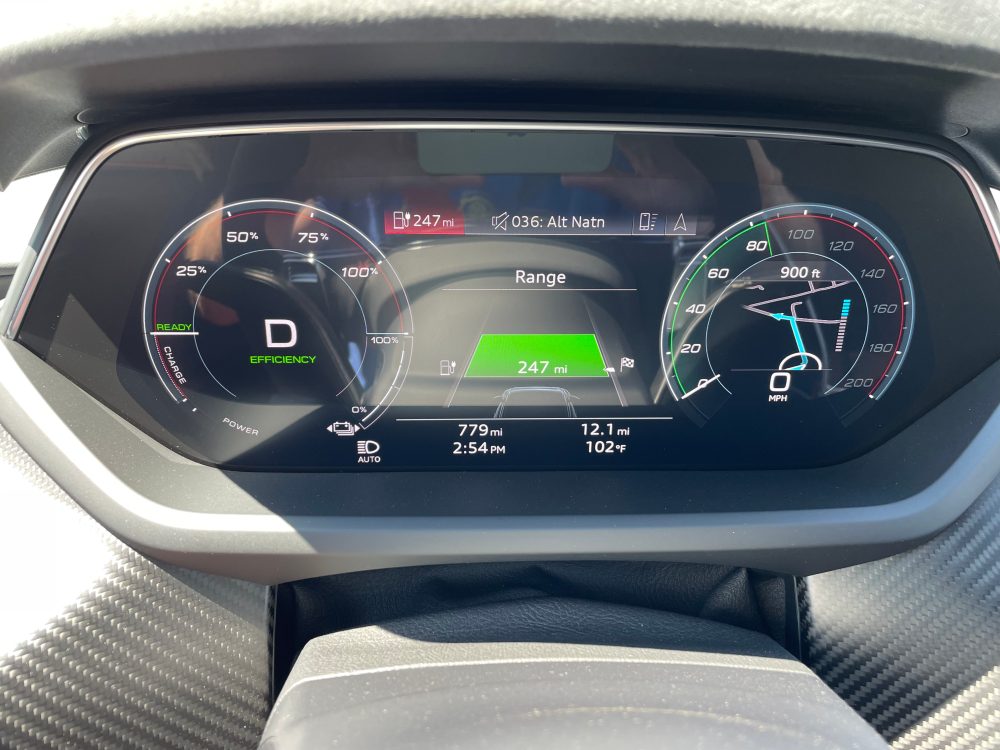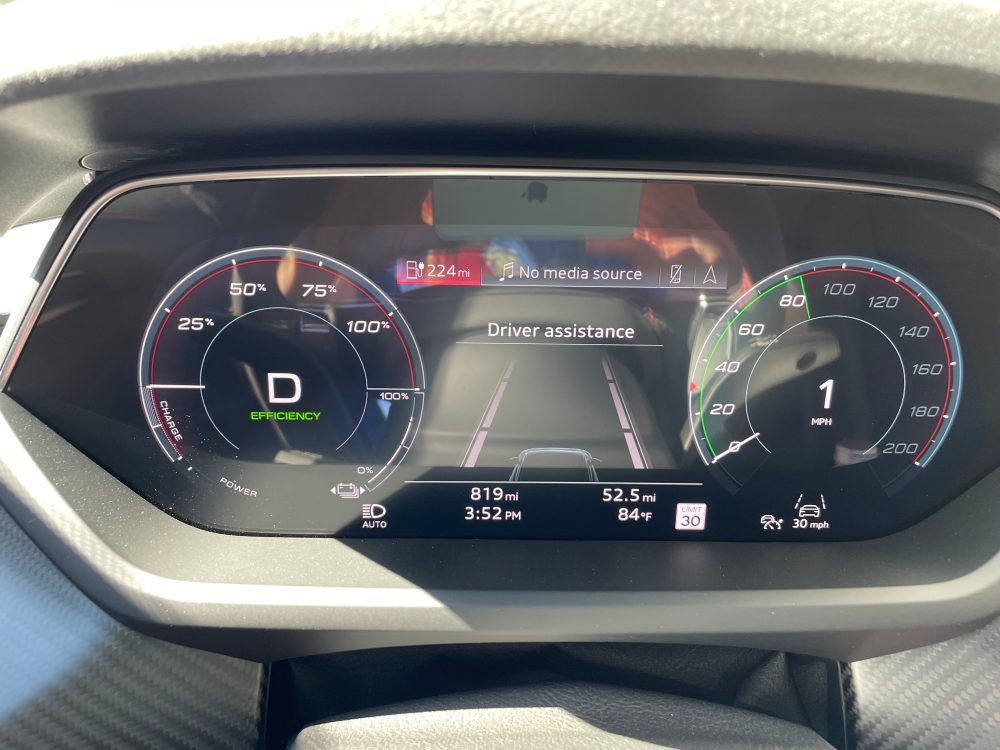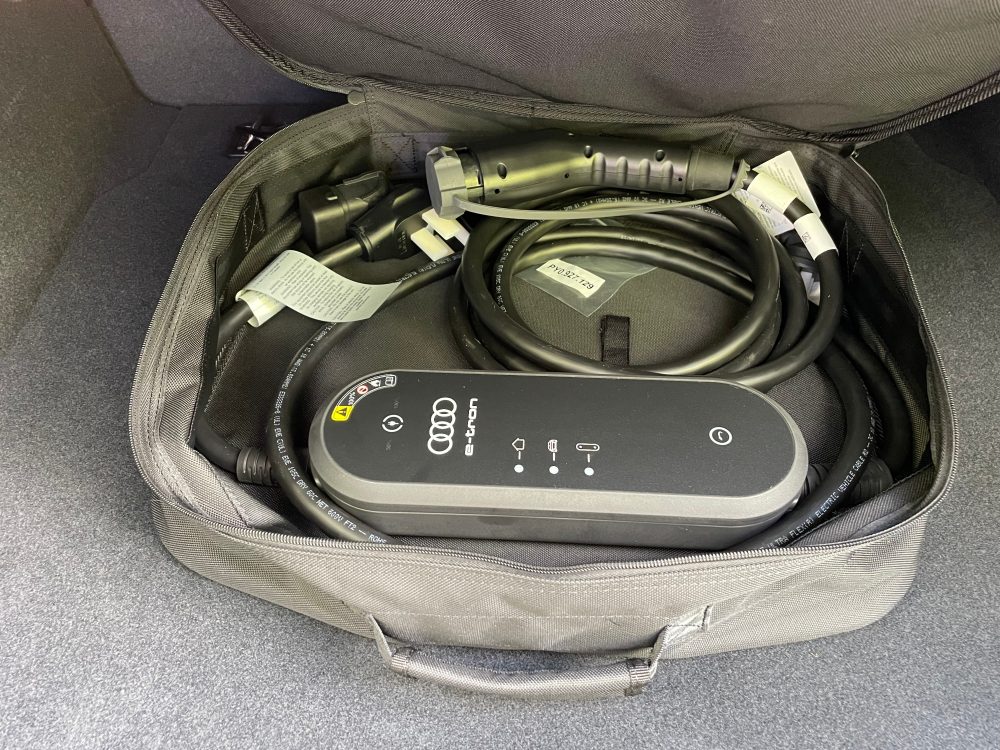
Audi invited us out to Los Angeles for a test drive of the Audi e-tron GT and Audi RS e-tron GT on the scenic Angeles Crest highway to get a feel for just how ridiculously powerful and controlled their new electric car is.
This is Electrek‘s second drive of the new Audi RS e-tron GT. Seth got to drive one in the Adirondacks earlier this year and came away impressed with its power and luxury. He also took far more pictures than I did, so if you’re looking for more visual stimulation, click through to his article.
But as I’m wont to do, I’ll go a little (okay, maybe a lot) deeper into some impressions I had from my California drive and hopefully answer a few unanswered questions you might have about this vehicle.
Performance
Right off the bat, the Audi RS e-tron GT’s performance leaves very little to be desired. At 637 horsepower in launch control mode, Audi says that the RS e-tron GT is the most powerful vehicle they’ve ever produced, gas or electric. That’s right – even more power than the V10 R8.
But the non-RS GT is no slouch either at 522hp. No matter what speed we were driving at during our canyon drive and on the freeway beforehand, the GT had real throw-you-back-in-the-seat oomph.
I even got a chance to take the RS model for a full launch control 0-100mph test on a local airfield. Launch control is engaged by stopping the car, turning off stability and traction control through a switch on the dash, then holding both the brake and the accelerator at the same time until the speedometer shows a little animation. This gives drivers access to every bit of the e-tron GT’s power and ensures an optimal repeatable 0-60 and 0-100 time.
Among all the journalists at the event, we saw an average of about 3.2 seconds 0-60mph and 7.3 seconds 0-100mph for the RS, just about in line with Audi’s quoted 3.1 second time. The rear motor has two gears and the shift happens around 40-50mph, which is perceptible but doesn’t result in any significant jerking or slowdown between the gears. Audi said that under the right conditions the RS will even chirp the tires when it shifts gears, though I didn’t hear that myself.
The non-RS GT has a 0-60 time of 3.9 seconds, though I didn’t get a chance to test that myself.
But it’s not just a straight-line monster. This Audi is wide and low, with big fat tires (the RS has 305s on the rear, which look enormous from behind):

Between that and all-wheel drive, e-torque vectoring, and rear-wheel steering, this meant that the e-tron GT handled a spirited canyon drive with little drama. I, on the other hand, didn’t – in my gradually increasing attempts to see how well the car handles, I managed to make myself carsick before I produced any drama from the vehicle. You’ve beat me this round, Audi.
The e-tron GT comes with multiple drive modes – efficiency, comfort, and dynamic – which modify vehicle dynamics. I spent most of the canyon drive in dynamic mode, and the ride home on the highway in efficiency mode.
If I had to complain about anything to do with performance, it would be that the accelerator didn’t feel very linear. In multiple drive modes, I’d see a gradual rise from 0 to 30 or 40% power, then suddenly with just a little more throttle input, the car would be throwing 100% of its power down (or close to it).
This was exciting to feel, to have the car push surprisingly hard when you asked for it, but sometimes I felt like it got a little ahead of what I was asking of it. Perhaps “comfort” or a custom drive mode would have moderated this behavior, or it could have been a remnant of some sort of throttle input smoothing being done by Audi – delaying inputs slightly in the name of driver or passenger comfort.
While I have not driven the GT’s sister car, the Porsche Taycan, Seth said in his first drive that the Audi’s throttle seems smoother than the Taycan’s throttle. For some drivers this might feel nice, but for me I would much rather have more direct and linear control of the vehicle’s power.
This throttle control complaint doesn’t just apply to acceleration, but deceleration as well. I didn’t do any emergency stops, but I’m sure the Audi e-tron GT’s big brakes (with available carbon ceramic brake system) will be more than adequate. However, the regenerative braking left a lot to be desired.
Range and efficiency
Experienced EV drivers have come to enjoy being able to control a car with one pedal, and that’s just not possible with the e-tron GT, as off-throttle regen is very weak. There are paddles behind the steering wheel which allow three levels of adjustment, but those levels are all weak.
Audi claims that this is more efficient, because coasting or maintaining constant speed is more efficient than bouncing back and forth between regenerating and accelerating. This is true, but strong regenerative braking doesn’t preclude coasting, and weak regenerative braking may lead to using the friction brakes more often, which means more energy loss.

In practice, there’s probably not a significant effect on efficiency, particularly since Audi’s brake-by-wire system will still engage regenerative braking before resorting to the friction brakes. There is, however, an effect on driveability – practiced EV drivers will lose the one-pedal control which so many of us enjoy, and new EV drivers might find a familiar system but will not gain the benefit of learning how good one-pedal driving can be.
While I understand Audi’s position – trying to keep it familiar for customers coming from ICE cars – it would be easy enough to add more selectable off-throttle regen levels to accommodate other driving styles.
Getting beyond my ever-present regenerative braking rant, the Audi’s efficiency is quite good. Its 93.4kWh battery, shared with the Porsche Taycan, has been rated at 238 miles of range and 82MPGe (232mi and 81MPGe for the RS). The Audi has a drag coefficient of .24, and its low-slung roof also helps to keep drag low – it’s the second-lowest Audi, just 1.8 inches taller than the R8.
Those rated range numbers don’t seem so high, but on our short drive, the car outperformed them significantly. In good driving conditions mostly on the highway, the RS e-tron GT used only 23 miles of battery range to drive 40 miles.
We can’t say this for certain without some more testing, but a naive extrapolation of our limited experience would suggest one could drive this Audi significantly farther than EPA estimates suggest in good conditions.
Even cold conditions shouldn’t affect the e-tron GT as much as many other EVs, as it has a heat pump to make cold-weather climate control more efficient.
We didn’t get a chance to charge the car, so we can’t comment on its charging rate. Audi says the GT can charge at up to 270kW, which is plenty fast. It can add 120 miles of range in 10 minutes or 180 miles in 22 minutes (charging slows down as batteries fill up, that’s why these numbers aren’t linear).
If the Audi’s charging performance is anything like the Taycan’s, then it shouldn’t disappoint. As long as you have access to a fast-enough DC quick charge station, you’ll easily be back on the road by the time your pit stop is over. Audi includes three years of complimentary charging on Electrify America’s network with purchase of the vehicle.
Audi has also partnered with Qmerit for optional “white glove” 9.6kW home charger installation services.
Tech gizmos
This is a car that doesn’t skimp on the buttons and extra features, to the point that I wasn’t able to test many of them because there are so many (their media info press kit is eight pages long). Also, carving canyons in a beast of a car like this demands one’s full attention, of course.
The Audi e-tron GT has a good slate of driver assist features, namely lane-keep assist and traffic-aware cruise control. The traffic aware cruise control worked very well on the highway, without confusion during lane changes and other maneuvers. Lane keep assist gives a light tug of the steering wheel when the car detects drifting out of the lane, and if driver input isn’t detected, the car almost immediately goes into “emergency SOS” mode and makes a lot of noise while threatening to call 911.
If cruise control and driver assist are both on and the car detects lane lines, it will activate lane centering along with cruise control. Unfortunately we couldn’t test this feature due to a configuration problem deep in the settings menus, and we did notice the car was a little inconsistent in its recognition of lane lines in difficult environments (like, for example, Sunset Boulevard in LA).

Speaking of menus – the car has your standard major automaker infotainment system that feels a little laggy and a little overcomplicated. Audi says that the system will be capable of over-the-air updates. But it also has wireless CarPlay and Android Auto, so you’ll probably end up using those more often than the native infotainment system.
The heads-up display helps reduce the need to look at the infotainment system, as relevant information is shown on the windshield in front of the driver. This is great – unless you’re wearing polarized sunglasses, which make it difficult to see the information reflected onto the windshield. Whoops.
For phone charging, the car comes with USB-C outlets in the center console armrest compartment, so you’ll need an adapter if you have an iPhone (Audi sells two for $91, but you can use cheaper ones just the same). Audi also sells a Qi charging pad, but as best we can tell there’s not really a convenient spot in the interior to put it.
Audi’s fancy new Matrix headlights are available as an option on this vehicle, which Audi was eager to point out. These headlights are currently not fully enabled in the US, though, due to government regulations. Audi is eager to get those regulations changed, but road regulations tend to change quite slowly in the US.
The laser lights do contribute to Audi’s “welcome animation,” which the car’s exterior lights play when you approach the vehicle. This is just a gimmick, but you know what? It’s a fun one. Anyone who has driven a Tesla Model S knows that it’s fun to walk up to the car and have it respond to your presence by presenting the door handles to you, almost like a dog that’s excited to go for a walk. Touches like this add to the customer experience and show attention to detail, and are welcome.
Another example of (perhaps excessive) attention to detail is the RS version’s “e-tron sport sound,” a specially designed sound intended to enhance the emotion of driving the vehicle, piped through internal and external speakers on acceleration. Audi used 32 individual sound layers to produce this singular sound, including a drone, power tools, and a didgeridoo blowing through a fan, among others. They certainly put a lot of work into this one, but in my opinion fake EV sounds are quite silly and I would prefer going without them. In the RS e-tron GT’s case, the driver can choose to turn this sound on or off, so I guess that’s fine.
One set of buttons I unfortunately did not think to test were the heated, cooled, and massaging seats. However, in previous experience in the e-tron SUV – the most comfortable car I’ve ever sat in – these were phenomenal. The SUV is roomier than this, so the GT doesn’t feel quite so luxurious, but if the seat massagers are the same, then they come with my endorsement.
Comfort, practicality, and… value?
This is a low, luxury sportscar, so right off the bat we have to acknowledge that practicality and value are not the top priorities here.
With a price that starts at $92K (post-federal-incentive) and only goes up from there, value is a question that’s hard to answer. This is not a car for bargain shoppers, and likely won’t be the only car that many customers own. So it’s hard to call it a “value” buy, but the level of comfort, luxury, performance, and style do seem to fit the segment, so at least the price is appropriate in that sense.
Also, we could take another view of the word “practicality” – one that is more about fitness for purpose, not fitness for every purpose. This is a car for driving, not for helping your friend move to a new apartment.
In that sense, it has a level of “practicality,” in that it’s an easy and comfortable car to drive. It benefits from the inherent practicality of an electric vehicle, which can be charged at home and has low maintenance needs, which means those gas station or oil change visits won’t get in the way of your driving. And the large battery and fast charging capability means it will work well for road trips as well, while keeping you and your passengers comfortable.
While the roof is low, the vehicle does not feel cramped inside (but then, I drive a very small car myself, so take my opinion of “cramped” with a grain of salt). The rear seats have a “foot garage,” a portion of the floor that has been lowered to give more legroom at the expense of a small amount of battery space.
The trunk is reasonably ample (at 9.2 cubic feet) and both rear seats fold down, laying close to flat. It also has a 1.8 cubic foot “frunk” under the hood. A bag with charging adapters is included, and the charger can be installed on a wall via an optional hook accessory. This way, it can live in your garage, connected to a NEMA 14-50 outlet, but can be unplugged and brought along if needed.
All told, it’s probably not enough cargo room for four people plus their stuff for a long road trip, but it should be serviceable for a weekend getaway.
Conclusion
Personally, I do think that Audi missed some marks by keeping one foot in their traditional mentality. The e-tron GT also feels over-engineered in some aspects – buttons and hidden options and multiple-step methods of activation and vehicle handling/acceleration aids making decisions for you and artificial motor noises, all of which complicate matters for those of us who prefer simpler and cleaner interfaces.
In my opinion, EVs are generally better the further they get from a “let’s keep this familiar for our ICE customers” mentality. This allows automakers to focus on the advantages of EVs to make a better vehicle, rather than keeping the old ways for familiarity’s sake (see: Audi’s regen braking levels). Rather than the oft-repeated goal of making “a great car that happens to be electric,” one could make “a better car because it’s electric.”
But for customers who aren’t as ready for radical change as I am, perhaps that’s all a plus rather than a minus.

So even if this is not the car for me – neither am I the customer Audi is aiming for. For those customers, current luxury car owners who have a high budget who want a car that is both comfortable and sleek but still familiar, with lots of bells and whistles (however cluttered a dashboard this might result in), and an insane amount of power they’ll never need but want to have, then this is the car for them.
That’s a rare customer, but a $100K-$160K car is a rare car. Audi isn’t looking for world-beating Corolla-level sales here; they’re looking to make a splash in a narrow market of customers who want a car that doesn’t compromise on the things they’re used to.
And in that way it seems like this car is a success.

The existence of this car will reassure those customers that they’re not losing anything in the transition to electric vehicles – and in fact that they’re gaining something with an easy-to-maintain car with more power than anything Audi has ever made.
And every step we take at chipping away a few of those customers, at offering an R8-beating halo car for people to salivate over, gets us a little closer to the necessary goal of electrifying all transportation, which we have to hit as soon as possible.
Audi is doing their part by offering “the most electric models of any manufacturer” by the end of 2021 – five, by their count (e-tron, e-tron Sportback, e-tron GT, Q4 e-tron, and Q4 e-tron Sportback).
I think they could have made a few different decisions with this car, but they have produced a car that is fundamentally worthy of desire, which is the goal of a luxury rocket like this after all.
The Audi e-tron GT and Audi RS e-tron GT are available now, and can be configured on Audi’s website.
FTC: We use income earning auto affiliate links. More.










Comments